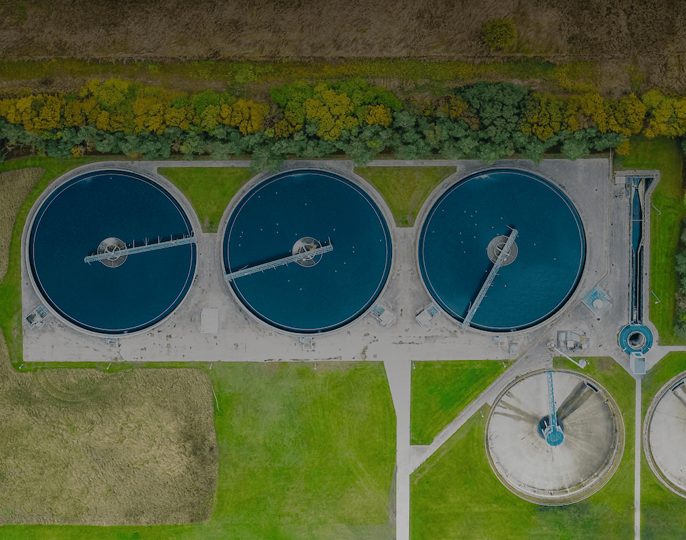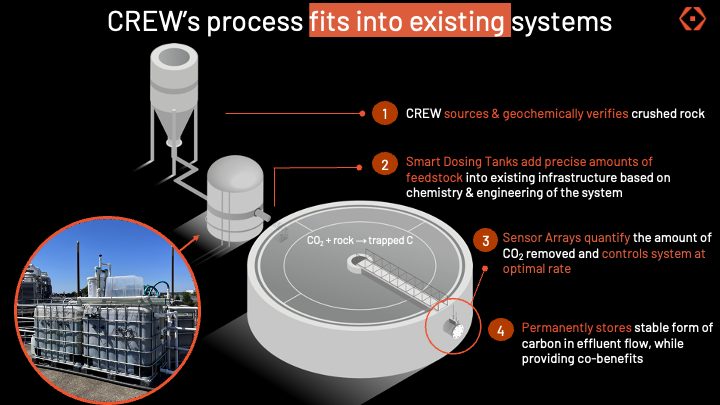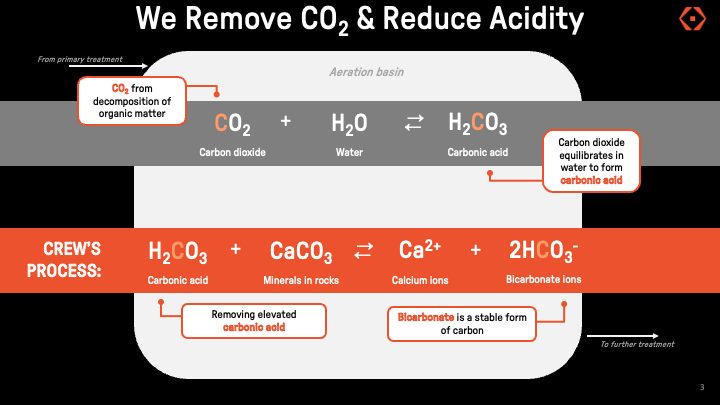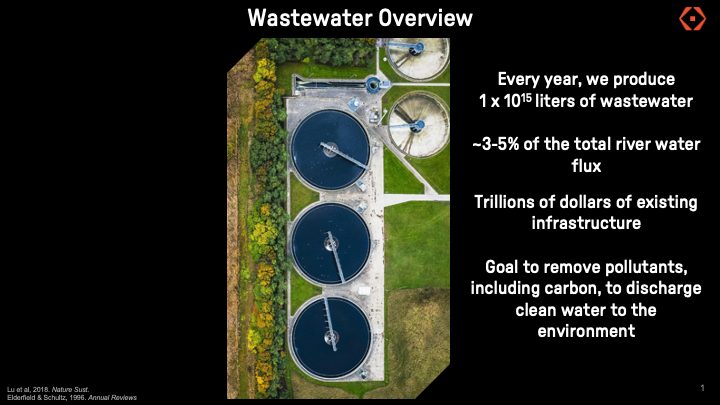Revolutionary Carbon Capture Method Integrated into Wastewater Treatment Plants
In episode #80 of Open Air’s video series, “This is CDR”, featured Joachim Katchinoff and Kevin Vu from Crew Carbon. This company approaches carbon removal through enhanced weathering in wastewater facilities. Crew Carbon’s approach combines nature-based solutions with engineered processes to enhance carbon dioxide removal (CDR) and help combat climate change.
Enhanced weathering is the process of accelerating the natural weathering reactions that remove carbon dioxide (CO2) from the atmosphere by exposing rocks to CO2-rich compounds. This process dissolves the rocks and converts CO2 into a stable form, bicarbonate ions, which can be transported to geological reservoirs and stored for thousands or millions of years.
Wastewater facilities produce a significant amount of CO2 as a byproduct of microbial decomposition of organic matter. By adding rocks and minerals to these facilities, these react with CO2 produced during wastewater treatment and trap it as dissolved bicarbonate ions.
The pioneering system of Crew Carbon using wastewater treatment facilities is the result of collaborative efforts by a team of visionary scientists and engineers, like Joachin and Kevin themselves, who have successfully harnessed existing wastewater infrastructure. These developments bring several advantages to CDR, such as the ability to work in tandem with existing wastewater treatment operations, thereby minimizing disruptions and effectively utilizing the resources already in place. Other advantages of Crew Carbon’s approach include the ability to quantify the amount of CO2 removal, adjust the pH levels in wastewater to benefit the microbial decomposition of organic matter, comply with regulatory requirements for pH and nutrient removal, and generate carbon credits that can be sold on carbon markets, among others.
The scientists at Carbon Crew estimate a capacity to eliminate hundreds of millions of tons of CO2 emissions annually. Thus, this technology has the potential to make a substantial dent in the global effort to mitigate climate change, particularly within the United States, where the company is based. In addition, this innovative system’s significance goes beyond CO2 capture. It has the potential to revolutionize the reduction of nitrous oxide emissions, a potent greenhouse gas with far-reaching implications for climate change. By addressing multiple greenhouse gasses, this integrated carbon capture method emerges as an innovative solution for CO2 removal.
Despite its promising prospects, as with any novel technology, some challenges must be addressed. Concerns include the potential settling of minerals within wastewater treatment facilities, which may impact the effectiveness of the process. Nonetheless, the substantial benefits of this system far outweigh these concerns. In terms of cost-effectiveness and energy efficiency, it surpasses several other carbon removal methods, including direct air capture. This aspect makes it even more attractive and practical for widespread adoption.
The integration of this carbon capture system into wastewater treatment plants is, without a doubt, a game-changer in the world of climate mitigation. The ability to utilize and adapt existing infrastructure streamlines the adoption process and makes it a cost-effective and practical solution for various wastewater facilities. The potential to capture vast amounts of CO2 and significantly reduce greenhouse gas emissions, along with its broader applications in tackling other greenhouse gas emissions, underscores this breakthrough’s immense potential. As we continue our journey toward a more sustainable future, this carbon capture innovation is undoubtedly a cause for optimism and a great example of how human ingenuity may be used for the betterment of our planet.
Carolina Ortiz Guerrero is a Geoscientist with 3+ years of experience in science communication who just graduated from her Ph.D. in Geological sciences. Her interests revolve around promoting awareness and enjoyment of Earth and atmospheric sciences by using a creative approach in writing and multimedia production. She co-founded a scicomm project called geoLchat, which promotes science in social media using multimedia, infographics, and interviews with scientists. In remineralize the Earth, Carolina promotes the project by writing news articles and creating social media content.
Support us on Patreon
Thank you for joining us today! Please become a member of RTE and support us on Patreon. Unlike many larger organizations, we work with a team of determined and passionate volunteers to get our message out. We aim to continue to increase the awareness of remineralization to initiate projects across the globe that remineralize soils, grow nutrient dense food, regenerate our forests’ and stabilize the climate – with your help! If you can, please support us on a monthly basis from just $2, rest assured that you are making a big impact every single month in support of our mission. Thank you!












Got something to say?